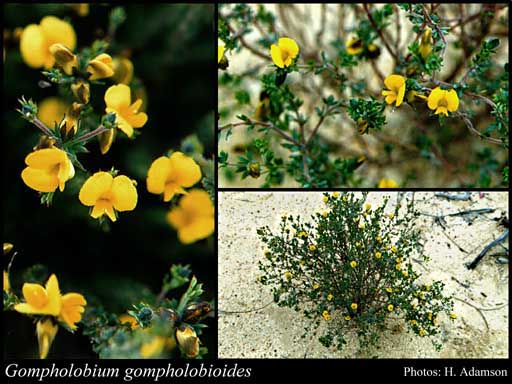- Reference
- C.H.Stirt., Adv.Legume Syst. 3: 129 (1987)
- Conservation Code
- Not threatened
- Naturalised Status
- Native to Western Australia
- Name Status
- Current
Spreading shrub, 0.07-0.4 m high. Fl. yellow, Sep to Dec or Jan to Mar. Yellow or red sand, gravelly sand. Sandplains, dunes.

Scientific Description
Genus Gompholobium. Form prostrate,spreading or scrambling. Habit shrub, spindly shrub (broom-like). Stems Indumentum glabrous, Pustules or glands absent, Striation (stems ribbed) not striate, Cross section terete, Spiny on any part of plant not spiny. Leaves or phylloclades Presence clearly present, Position whorled, Leaves compound, Leaves or phylloclade continuous with stem not continuous with stem, Cross section of leaf or leaflet flat with flat margins, Margins of leaf or leaflet entire, Tuberculate tubercles absent, Pustules or glands absent. Length Leaf length 3.5-5.5. Width (entire leaves only) Leaf width NaN (?). Scale leaves length mm long NaN (?). Leaflets Arrangement pinnately arranged. Terminal leaflet Presence present, Stalk sessile (?) or stalked (?). Indumentum Presence hairy, Type simple. Stipules Presence present and persistent to older leaves, Glands with glands (?) or without glands (?), Ribs ribbed (?) or ribless (?). Length Stipule length NaN (?). Bracteoles Presence present and persistent, Indumentum hairy (?) or glabrous (?), Striation striate (?) or not striate (?). Length Bracteole length NaN (?). Pedicel Presence present, Indumentum glabrous. Length Pedicel length 1-1.5. Calyx Pustules or glands absent, Ribs ribless, Enlarged in fruit not accrescent. Length Calyx length 6-6.5. Indumentum Presence hairy, Type with simple hairs. Corolla Colour patterning uniformly coloured, Colour (when uniformly coloured) yellow, Petal claws ( the narrow base of the petals present. Length Corolla length 7-9. Indumentum Presence absent. Standard Indumentum glabrous, Auricles not auriculate. Length Standard length 6-8. Wings Auricles not auriculate. Length Wing length 5-6.6. Keel Auricles not auriculate, Indumentum glabrous, Beak not beaked. Length Keel length 5-6.5. Stamens Number ten. Anthers anther length 0.4-0.6, Position at two different levels (filaments alternately long and short). Filaments Fusion free (or united at the very base). Length Filament length 3.5-5.3. Ovary Placement sessile or subsessile. Indumentum Presence glabrous. Style Indumentum glabrous, Bearded ( with a tuft of hairs at apex ) not bearded, Apex terete. Length Style length 5.4-5.5. Fruit Type dehiscent (a pod or follicle), Constriction not constricted between the seeds, Compression round in cross-section, Placement sessile or subsessile, Beak not beaked. Length Fruit length NaN (?). Width Fruit width NaN (?). Indumentum Presence glabrous. Flowering time January, February, March, September, October, November or December. Distribution Botanical Province Eremaean or South-West, IBRA Bioregion Yalgoo, Great Victorian Desert, Geraldton Sandplains, Avon Wheatbelt, Mallee or Esperance.
Distribution
- IBRA Regions
- Avon Wheatbelt, Coolgardie, Esperance Plains, Geraldton Sandplains, Great Victoria Desert, Mallee, Yalgoo.
- IBRA Subregions
- Eastern Goldfield, Eastern Mallee, Fitzgerald, Geraldton Hills, Lesueur Sandplain, Merredin, Shield, Southern Cross, Tallering, Western Mallee.
- Local Government Areas (LGAs)
- Chapman Valley, Coolgardie, Dumbleyung, Dundas, Esperance, Greater Geraldton, Kalgoorlie-Boulder, Kent, Kondinin, Koorda, Kulin, Lake Grace, Menzies, Merredin, Moora, Morawa, Mount Marshall, Narembeen, Northampton, Perenjori, Ravensthorpe, Trayning, Yilgarn.